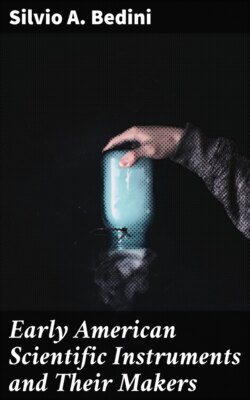Читать книгу Early American Scientific Instruments and Their Makers - Silvio A. Bedini - Страница 7
На сайте Литреса книга снята с продажи.
Philosophical and Practical Instruments
ОглавлениеTable of Contents
Development of the sciences in the American Colonies was critically dependent upon the available tools—scientific instruments—and the men who made and used them. These tools may be separated into two groups. The first group consists of philosophical instruments and scientific teaching apparatus produced and employed for experimentation and teaching in educational institutions. The second includes the so-called "mathematical instruments" of practical use, which were employed by mathematical practitioners and laymen alike for the mensural and nautical needs of the Colonies. It is particularly with this second group that the present study is concerned.
It has been generally assumed that scientific instruments, as well as the instrument makers, of the first two centuries of American colonization were imported from England, and that the movement declined by the beginning of the 19th century with the development of skilled native craftsmen.[1] This assumption is basically true for those instruments grouped under philosophical and scientific apparatus for experimentation and teaching. Almost all of these items were in fact imported from England and France until well into the 19th century.
Likewise, the very earliest examples of mathematical instruments for surveying and navigation in the Colonies were imported with the settlers from England. It was not long after the establishment of the first settlements, however, that the settlers, and later the first generation of native Americans, began to produce their own instruments. Records derived from historical archives and from the instruments themselves reveal that a considerable number of the instruments available and used in the Colonies before 1800 were of native production. Apparently, relatively few instrument makers immigrated to the American continent before the end of the Revolutionary War. Later, with the beginning of the 19th century, makers of and dealers in instruments in England and France became aware of the growing new market, and emigrated in numbers to establish shops in the major cities of commerce in the United States.
Quite possibly the few instrument makers trained in England who immigrated to the Colonies in the early epoch of Colonial development may have in turn trained others in their communities, although no evidence has yet been found. Perhaps more data on this aspect of the subject will eventually come to light.
There is reason to believe that a few mathematical practitioners and instrument makers lived and worked in the New England colonies as early as the first century of colonization.
The evidence, frankly meager, consists of two items. The first is a reference relating to James Halsie of Boston. In a land deed made out to him in 1674 he was referred to as a "Mathematician."[2] Halsie was listed as a freeman of the Massachusetts Bay Colony in 1690. He apparently was the forbear of the several members of the Halsy family of instrument makers of Boston of the 18th century, mentioned later in this study. It is uncertain whether the use of the term "mathematician" in this connection meant an artisan, but if not it may be inferred that Halsie was a practitioner.
The second piece of evidence is even more slender; it consists of an inscription upon a dialing rule (fig. 1) for making sundials and charts. The instrument is of cast brass, 20–7/16 inches long and 1–11/16 inches wide. The date "1674" is inscribed on the rule together with the name of its original owner, "Arthur Willis." The instrument almost certainly was produced by the school of Henry Sutton, the notable English instrument maker who worked in Threadneedle Street in London from about 1637 through 1665. The name and date inscriptions are consistent and contemporary with the workmanship of the rule, and were probably inscribed by the maker for the original owner. It is conceivable that Arthur Willis was an Englishman and that the rule was brought into this country even in relatively recent times. However, it is claimed that the rule was owned and used by Nathaniel Footes, surveyor of Springfield, Massachusetts. Nathaniel Footes, believed to have been originally from Salem, subsequently moved from Springfield to Wethersfield, Conn. The instrument was later owned and used in Connecticut not later than the early 19th century[3] by the forbears of Mr. Newton C. Brainard of Hartford, Connecticut. If records relating to Willis as a resident of the New England colonies can be recovered, it may then be possible to establish whether he worked in the Colonies as a mathematical practitioner in the 17th century. His name is included on a tentative basis.
Figure 1.—Dialing rule made of brass and inscribed with the name "Arthur Willis" and the date "1674." Allegedly used by Nathaniel Footes, surveyor of Springfield, Massachusetts. Photo courtesy Newton C. Brainard, Hartford, Connecticut, and the Connecticut Historical Society.
